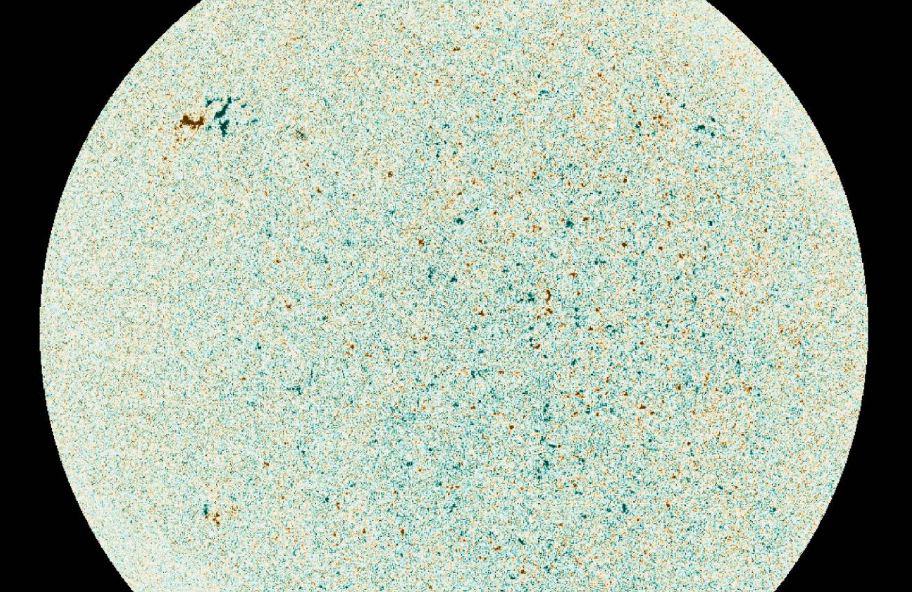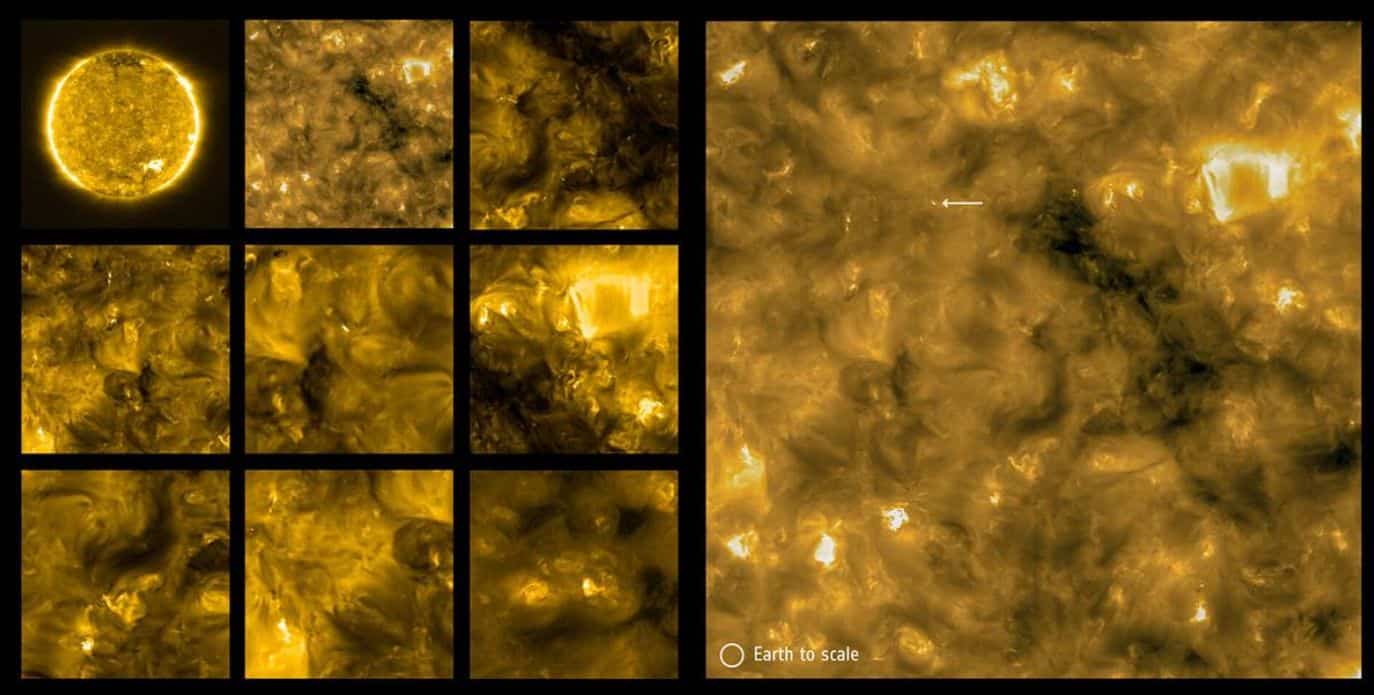After its launch on February 10, the Solar Orbiter mission of the European Space Agency (ESA), in collaboration with NASA, has begun to send its spectacular images of the Sun, the closest-ever captured so far of our star.
“They are only the first images and we can already see new phenomena of interest,” says Daniel Müller, a scientist at ESA’s Solar Orbiter project. “We did not expect such good results from the beginning, and we have also been able to see how the ten scientific instruments complement each other, offering a comprehensive image of the Sun and its environment.”
The ‘bonfires’ captured by the first images of Solar Orbiter are like minor relatives of the solar flares observed from Earth but between millions and billions of times smaller.
Solar Orbiter includes six remote sensing instruments (telescopes), which will observe the Sun and its surroundings, and four on-site instruments to probe the environment around the spacecraft. By comparing the data from both classes of instruments, the information will be obtained on how the solar wind is generated, the rain of charged particles from the Sun that affects the entire solar system.
Poro what makes Solar Orbiter unique is that, until now, no other mission has been able to take pictures from so close to the solar surface.
One of the results is the ‘bonfires’ that appear in the photographs captured by the Extreme Ultraviolet Image Camera (EUI) during the first perihelion of Solar Orbiter, the point in its elliptical orbit closest to the Sun. At that time, The spacecraft was just 77 million km from the Sun, about half the distance from Earth to our star.
“These bonfires are like minor relatives of the solar flares observed from Earth, but between millions and billions of times smaller,” says David Berghmans, of the Royal Observatory of Belgium (ROB) and principal investigator of the EUI instrument, which takes high-resolution images of the lower layers of the solar atmosphere, or corona. “At first glance, the Sun may appear motionless, but as you look closely we can see these small eruptions everywhere.”
The mysterious warming of the crown
The researchers still don’t know if they are tiny versions of large flares or if they are due to different mechanisms. In any case, there are already theories that these ‘small’ eruptions could contribute to one of the most enigmatic phenomena in the Sun: the heating of the corona.
“Each of these bonfires is insignificant by itself, but if we add its effect across the entire surface, they could contribute significantly to the heating of the solar corona,” explains Frederic Auchere, from the French Institute for Space Astrophysics (IAS) and EUI co-principal investigator.
The solar corona is the outermost layer of the Sun’s atmosphere, stretching millions of kilometres into outer space. Its temperature exceeds one million degrees Celsius, several orders of magnitude warmer than the surface of the Sun, which is “barely” at 5,500 ° C. After decades of studies, the physical mechanisms that heat the corona are still not fully understood, but identifying them is considered the ‘holy grail’ of solar physics.
Thanks to the PHI instrument, co-led by the Institute of Astrophysics of Andalusia, the first magnetic map of the Sun obtained autonomously from space has been provided
“Logically, it is too early to know, but we trust that, by linking these observations with the measurements of the rest of the instruments that study the solar wind that passes next to the spacecraft, we can solve some of these mysteries,” says Yannis Zouganelis, an Associate scientist for ESA’s Solar Orbiter project.
For its part, the Polarimetric and Helioseismic Imaging Camera (PHI) is another advanced instrument onboard Solar Orbiter. Make high-resolution measurements of the magnetic field lines on the solar surface. It is designed to monitor active regions of the Sun, areas with especially strong magnetic fields that could lead to flares.
During these flares, the Sun releases bursts of energetic particles that strengthen the solar wind that the star constantly releases into space. When these particles interact with the Earth’s magnetosphere, they can cause magnetic storms capable of disrupting telecommunications networks and electrical ground infrastructure.
“Right now we are in a part of the eleven-year solar cycle when the Sun is very calm,” clarifies Sami Solanki, director of the Max Planck Institute for Solar System Research in Göttingen (Germany) and principal investigator of PHI. “But since Solar Orbiter is at a different angle from the Sun than Earth, we could see an unobservable active region from our planet. That is something totally new; Until now we have never been able to measure the magnetic field of the hidden face of the Sun”.
The magnetograms, which show how the intensity of the magnetic field varies along the solar surface, could then be compared with measurements from the instruments in situ. For now, the ship has already provided its first magnetic map of the Sun, which is also the first obtained autonomously, that is, from space and without human intervention.

“The PHI instrument measures the magnetic field on the surface, while with EUI we see structures in the solar corona, but we also try to infer the lines of the magnetic field that extend to the interplanetary medium, where Solar Orbiter is located,” explains José Carlos del Toro Iniesta, from the Andalusian Institute of Astrophysics and main co-researcher of PHI.
“The image obtained with the high-resolution telescope provides the first autonomous magnetogram made in space,” stresses the researcher.
Capturing the solar wind
In addition, Solar Orbiter’s four on-site instruments have begun to characterize the lines of the magnetic field and the solar wind passing alongside the spacecraft.
Christopher Owen, of the University College London Mullard Space Science Laboratory and principal investigator of the Solar Wind Analyzer in situ (SWA), adds: “With this information, we can calculate from where the specific portion of the solar wind was emitted from the Sun, to then use the mission’s set of instruments to reveal and understand the physical processes that operate in the different regions of the Sun and that lead to the formation of the solar wind.”
These first images are only the ones from the beginning of Solar Orbiter’s long journey to the Sun, which he will get much closer to in less than two years.
“We are very excited about these first images, but they are only the beginning,” adds Müller. “Solar Orbiter has started a long journey through the inner solar system, and in less than two years it will get much closer to the Sun. In the end, it will approach only 42 million kilometres, which is almost a quarter of the distance from the Earth to the Sun”.
Solar Orbiter is a space mission resulting from the international collaboration between ESA and NASA. Twelve ESA Member States (Germany, Austria, Belgium, Spain, France, Italy, Norway, Poland, the United Kingdom, the Czech Republic, Sweden and Switzerland), as well as NASA, have contributed to the scientific payload. The satellite has been built by the prime contractor, Airbus Defense and Space, in the United Kingdom.
Spanish researchers have a leading role in two of the ten instruments on board the ship: the energy particle detector (EPD), led by the University of Alcalá and the University of Kiel (Germany); and the PHI magnetographer led by the IAA and the Max Planck Institute for Solar System Research (Göttingen, Germany).
